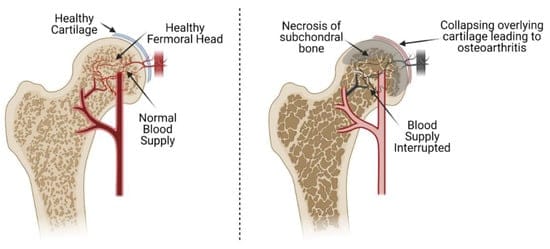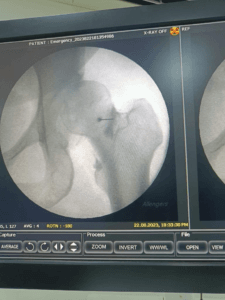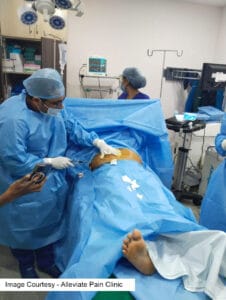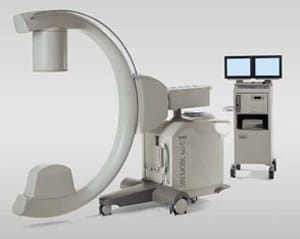Introduction
Avascular necrosis (AVN) of the hip, a condition characterized by the loss of blood supply to the femoral head, can be a debilitating and painful disorder. While surgical interventions have traditionally been the primary mode of treatment, recent advancements in regenerative medicine and image-guided therapies have provided promising non-surgical alternatives. At Alleviate, we have successfully implemented a combination of Stem Cells, Platelet-Rich Plasma (PRP), and prolotherapy for Stage 2 and early Stage 3 candidates, resulting in substantial improvements in pain, function, and stiffness, as well as the arrest of disease progression.
Understanding the Pathogenesis of Hip AVN

Before delving into non-surgical treatments, it is crucial to understand the pathogenesis of hip AVN. The disruption of blood supply to the femoral head initiates a cascade of events leading to the death of bone tissue. This process results in pain, limited joint mobility, and, if left untreated, may progress to joint degeneration. Non-surgical interventions aim to address the underlying vascular insufficiency, promote tissue regeneration, and alleviate symptoms.
Platelet-Rich Plasma (PRP):
35 year old make undergoing Hip Intrarticular Platelet Rich Plasma Inection under fluoroscopy.PRP therapy involves the extraction and concentration of platelets from the patient’s blood, which are then injected into the affected hip joint. Platelets contain growth factors that stimulate tissue repair and angiogenesis, potentially improving blood flow to the compromised femoral head. Numerous studies support the use of PRP in the treatment of AVN, highlighting its regenerative potential and ability to modulate inflammation.

Mesenchymal Stem Cells (MSCs):
Adipose( Fat ) Extraction from Abdomen for Mesenchymal Stem Cells Preparation at Alleviate Pain Clinic Bengaluru.Mesenchymal stem cells, derived from bone marrow or adipose tissue, have shown great promise in promoting tissue regeneration. These cells have the ability to differentiate into various cell types, including bone-forming cells. Studies have demonstrated the efficacy of MSCs in improving symptoms and slowing disease progression in hip AVN patients (Reference 2). Alleviate’s approach involves the precise injection of MSCs into the affected joint under image guidance for optimal placement and effectiveness.

Prolotherapy
Adipose( Fat ) Extraction from Abdomen for Mesenchymal Stem Cells Preparation at Alleviate Pain Clinic Bengaluru.Prolotherapy, or regenerative injection therapy, involves the injection of a solution (often containing dextrose or other irritants) into the affected joint and supporting ligaments. Fluoroscopy is often deployed for accurate needle placement.promoting the growth of new, healthy tissue. Research suggests that prolotherapy can enhance the healing process and improve joint stability (Reference 3). At Alleviate, we strategically incorporate prolotherapy into our treatment plan to address joint instability and support the overall regenerative process.

Viscosupplementation
Viscosupplementation involves the injection of hyaluronic acid into the joint to improve lubrication and reduce friction between bones. While traditionally used for osteoarthritis, recent studies have explored its potential benefits in AVN by enhancing joint function and reducing pain. Alleviate considers viscosupplementation as part of a multimodal approach to provide comprehensive relief.
Radiofrequency Ablation (RF Ablation)
RF ablation is a minimally invasive procedure that uses heat generated by radiofrequency energy to interrupt pain signals from nerve tissues. In hip AVN, RF ablation can be employed to manage pain and improve joint function. While not a direct treatment for the underlying pathology, it plays a crucial role in enhancing the patient’s quality of life during the regenerative process.
Conclusion
The integration of non-surgical interventions, such as Stem Cells, PRP, prolotherapy, viscosupplementation, and RF ablation, offers a promising avenue for the management of hip AVN. At Alleviate, our evidence-based approach focuses on combining these therapies for Stage 2 and early Stage 3 candidates, resulting in significant improvements in pain, function, and stiffness, as well as the halting of disease progression. As research in regenerative medicine continues to advance, non-surgical options for hip AVN hold the potential to revolutionize the treatment landscape, providing hope and relief to patients seeking alternatives to surgery.
References
- Smith PA. Intra-articular Autologous Conditioned Plasma Injections Provide Safe and Efficacious Treatment for Knee Osteoarthritis: An FDA-Sanctioned, Randomized, Double-blind, Placebo-controlled Clinical Trial. Am J Sports Med. 2016;44(4):884-891.
- Hernigou P, Poignard A, Zilber S, Rouard H. Cell therapy of hip osteonecrosis with autologous bone marrow grafting. Indian J Orthop. 2009;43(1):40–45.
- Rabago D, Mundt M, Zgierska A, Grettie J. Hypertonic dextrose injection (prolotherapy) for knee osteoarthritis: Long term outcomes. Complement Ther Med. 2015;23(3):388-395.
- Ozturk C, Atamaz F, Hepguler S, Argin M, Arkun R. The safety and efficacy of intraarticular hyaluronan with/without corticosteroid in knee osteoarthritis: 1-year, single-blind, randomized study. Rheumatol Int. 2006;26(4):314-319.





